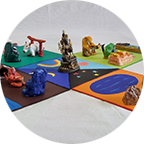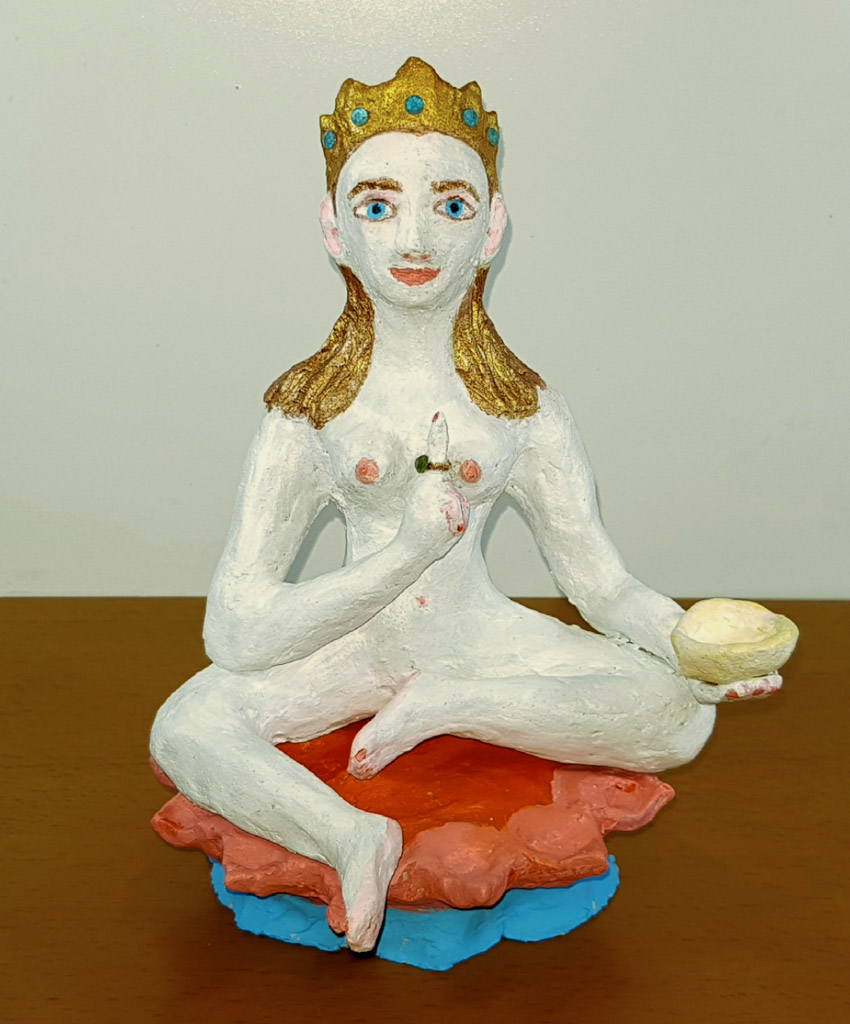Retelling: Vova Pyatsky and Smadar Pyatsky (based on the translations of the suttas published on Theravada.ru and SuttaCentral.net)
Russian Version: Махасиханада сутта, Великий Львиный Рык Будды, Мадджхима Никая 12 | Три Ваджры
Translation to English: Roni Sherman and Marina Sherman
Sariputta, after returning from a village where he collected alms, tells the Buddha of the words of Sunakkhata, a former member of the Sangha and personal servant of the Buddha (The story of Sunakkhata and the reasons why he left the Sangha are described in detail in Pattika Sutta, Dighan Nikaya 24). Sunakkhata told his fellow tribesmen that the Buddha has no supernatural powers or states; that the Teaching of the Buddha — is merely conclusions drawn from human reflection; that those who follow the Teaching of the Buddha only come to the cessation of suffering and not to something more remarkable.
In response, the Buddha tells Sariputta: Sunakkhata is driven by anger, but he, without knowing it, glorifies me. After all, there is nothing higher or more remarkable than the cessation of suffering. About higher power and states — the Awakened Ones possess them, but Sunakkhata cannot attain that because of his anger.
The Ten Awarenesses of the Buddha
1. Differentiation of what is possible and what is impossible (for example, the attainment of the cessation of suffering — is possible, whereas the attainment of happiness with the sacrifice of animals — is impossible)
2. Awareness of the results which actions have had, are having, and will have on consciousness (awareness of karma)
3. Awareness of the paths into different realms
4. Awareness of the impermanence of the visible world and its phenomena
5. Awareness of the tendencies of other beings
6. Awareness of the abilities of other beings
7. Awareness of the purification of the mind in states of concentration
8. Awareness of one’s past lives
9. Awareness of the fate of beings after death
10. Awareness of a state in which the stains of excitement are destroyed (nibbana) and the paths to this state
Four Bases for Tranquility
The Buddha is tranquil while in eight kinds of assemblies: the four assemblies of human beings and the four assemblies of higher beings. The four assemblies of human beings — are the assemblies of warriors, priests, laymen and hermits. The four assemblies of higher beings — are the assemblies of Kings of Dhamma, Beautiful gods in the heavens of Tavatimsa, Maras and Brahmas. The tranquility of the Buddha in these assemblies has four bases:
1) There is nobody in either the higher realms or in the human realm who could rightly accuse
the Buddha of lack of Enlightenment
2) Or of Him not attaining the end of defilements and stains
3) or of him calling things which are not obstacles obstacles
4) or of the Dhamma of the Buddha not leading to the complete cessation of suffering
Discernment of paths leading to suffering and paths leading to good
The Buddha, aware of a person’s deeds, his intentions, sees which world he goes to: to hell, to animal rebirth, to rebirth as an asura, human or a god.
Somebody who accumulates qualities which lead to hell is like a dehydrated, suffering person walking straight into a pit with coals of his past deeds burning without smoke or flame. After falling into this pit, he experiences only painful feelings piercing with pain.
Somebody who accumulates animal qualities is like a tired person suffering from heat, thirst and hunger who is walking straight into a cesspit. After falling into it, he experiences only unpleasant feelings filled with suffering.
One who accumulates qualities leading to birth as an asura is like a person suffering from heat who goes to a tree with sparse, twisted foliage in whose shadow he will experience many restless feelings.
One who accumulates qualities leading to birth as a human being is like a tired person suffering from heat going to a tree with dense, broad and thick foliage. In its shadow, this person will find many pleasant, calm feelings.
One who accumulates qualities leading to birth as a god is like a tired, exhausted person, thirsty and hungry, suffering from heat who goes straight into a beautiful house offering him all convenience for rest, drink and food.
One who accumulates qualities leading to nibbana is like an exhausted person suffering from heat who comes to a pure and wonderful pond with cool, clear water. This lake has a convenient bank, and the person, taking a dip, having removed fatigue and exhaustion, rests in the thick, friendly woods.
A path superior to austere asceticism
The Buddha indulged once in the most austere asceticism. When He talked about it, the body hairs of a disciple fanning the Blessed One stood on end. Nevertheless, even though the Buddha tortured himself with hunger, deprivation, exercise in insensitivity — his mind has not disposed of defilements. The Buddha attained liberation by following the Noble Eightfold Path (Samaditthi Sutta, Majjhima Nikaya 9)
Overcoming false views about liberation
There are different false views about liberation from suffering. Some believe that the wheel of reincarnation in itself leads to liberation, others believe that being born a brahmin or a king grants liberation, others believe that worship leads to liberation, others do not believe in liberation at all, believing that the mind is meant to fade away with the onset of old age. All of these views are false. There is no such world, reincarnation or knowledge which the Buddha would not have remembered while remembering his past lives. However they did not bring Him liberation. Only in the Pure Abodes is there non-return to samsara, and the Pure Abodes are accessible only to beings following the Noble eightfold Path.
The Buddha claims that his Knowledge is inexhaustible: Even if four accomplished disciples who ask only the right questions were each to question the Buddha about His Dharma for one hundred years, the exposition of the Dharma would not end.
Author
Retelling: Vova Pyatsky and Smadar Pyatsky (based on the translations of the suttas published on Theravada.ru and SuttaCentral.net)
Russian Version: Махасиханада сутта, Великий Львиный Рык Будды, Мадджхима Никая 12 | Три Ваджры
Translation to English: Roni Sherman and Marina Sherman
Sariputta, after returning from a village where he collected alms, tells the Buddha of the words of Sunakkhata, a former member of the Sangha and personal servant of the Buddha (The story of Sunakkhata and the reasons why he left the Sangha are described in detail in Pattika Sutta, Dighan Nikaya 24). Sunakkhata told his fellow tribesmen that the Buddha has no supernatural powers or states; that the Teaching of the Buddha — is merely conclusions drawn from human reflection; that those who follow the Teaching of the Buddha only come to the cessation of suffering and not to something more remarkable.
In response, the Buddha tells Sariputta: Sunakkhata is driven by anger, but he, without knowing it, glorifies me. After all, there is nothing higher or more remarkable than the cessation of suffering. About higher power and states — the Awakened Ones possess them, but Sunakkhata cannot attain that because of his anger.
The Ten Awarenesses of the Buddha
1. Differentiation of what is possible and what is impossible (for example, the attainment of the cessation of suffering — is possible, whereas the attainment of happiness with the sacrifice of animals — is impossible)
2. Awareness of the results which actions have had, are having, and will have on consciousness (awareness of karma)
3. Awareness of the paths into different realms
4. Awareness of the impermanence of the visible world and its phenomena
5. Awareness of the tendencies of other beings
6. Awareness of the abilities of other beings
7. Awareness of the purification of the mind in states of concentration
8. Awareness of one’s past lives
9. Awareness of the fate of beings after death
10. Awareness of a state in which the stains of excitement are destroyed (nibbana) and the paths to this state
Four Bases for Tranquility
The Buddha is tranquil while in eight kinds of assemblies: the four assemblies of human beings and the four assemblies of higher beings. The four assemblies of human beings — are the assemblies of warriors, priests, laymen and hermits. The four assemblies of higher beings — are the assemblies of Kings of Dhamma, Beautiful gods in the heavens of Tavatimsa, Maras and Brahmas. The tranquility of the Buddha in these assemblies has four bases:
1) There is nobody in either the higher realms or in the human realm who could rightly accuse
the Buddha of lack of Enlightenment
2) Or of Him not attaining the end of defilements and stains
3) or of him calling things which are not obstacles obstacles
4) or of the Dhamma of the Buddha not leading to the complete cessation of suffering
Discernment of paths leading to suffering and paths leading to good
The Buddha, aware of a person’s deeds, his intentions, sees which world he goes to: to hell, to animal rebirth, to rebirth as an asura, human or a god.
Somebody who accumulates qualities which lead to hell is like a dehydrated, suffering person walking straight into a pit with coals of his past deeds burning without smoke or flame. After falling into this pit, he experiences only painful feelings piercing with pain.
Somebody who accumulates animal qualities is like a tired person suffering from heat, thirst and hunger who is walking straight into a cesspit. After falling into it, he experiences only unpleasant feelings filled with suffering.
One who accumulates qualities leading to birth as an asura is like a person suffering from heat who goes to a tree with sparse, twisted foliage in whose shadow he will experience many restless feelings.
One who accumulates qualities leading to birth as a human being is like a tired person suffering from heat going to a tree with dense, broad and thick foliage. In its shadow, this person will find many pleasant, calm feelings.
One who accumulates qualities leading to birth as a god is like a tired, exhausted person, thirsty and hungry, suffering from heat who goes straight into a beautiful house offering him all convenience for rest, drink and food.
One who accumulates qualities leading to nibbana is like an exhausted person suffering from heat who comes to a pure and wonderful pond with cool, clear water. This lake has a convenient bank, and the person, taking a dip, having removed fatigue and exhaustion, rests in the thick, friendly woods.
A path superior to austere asceticism
The Buddha indulged once in the most austere asceticism. When He talked about it, the body hairs of a disciple fanning the Blessed One stood on end. Nevertheless, even though the Buddha tortured himself with hunger, deprivation, exercise in insensitivity — his mind has not disposed of defilements. The Buddha attained liberation by following the Noble Eightfold Path (Samaditthi Sutta, Majjhima Nikaya 9)
Overcoming false views about liberation
There are different false views about liberation from suffering. Some believe that the wheel of reincarnation in itself leads to liberation, others believe that being born a brahmin or a king grants liberation, others believe that worship leads to liberation, others do not believe in liberation at all, believing that the mind is meant to fade away with the onset of old age. All of these views are false. There is no such world, reincarnation or knowledge which the Buddha would not have remembered while remembering his past lives. However they did not bring Him liberation. Only in the Pure Abodes is there non-return to samsara, and the Pure Abodes are accessible only to beings following the Noble eightfold Path.
The Buddha claims that his Knowledge is inexhaustible: Even if four accomplished disciples who ask only the right questions were each to question the Buddha about His Dharma for one hundred years, the exposition of the Dharma would not end.

